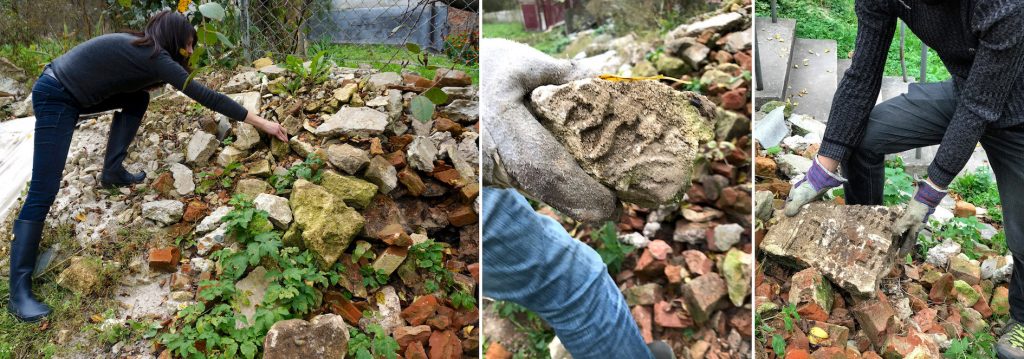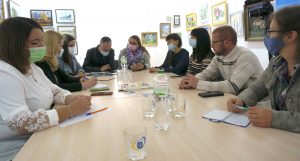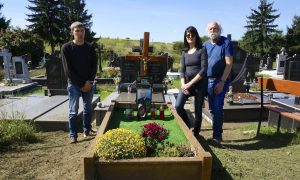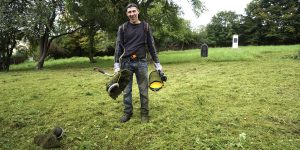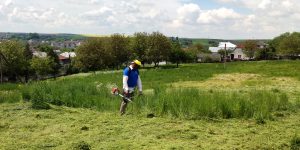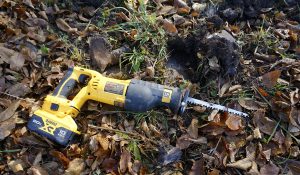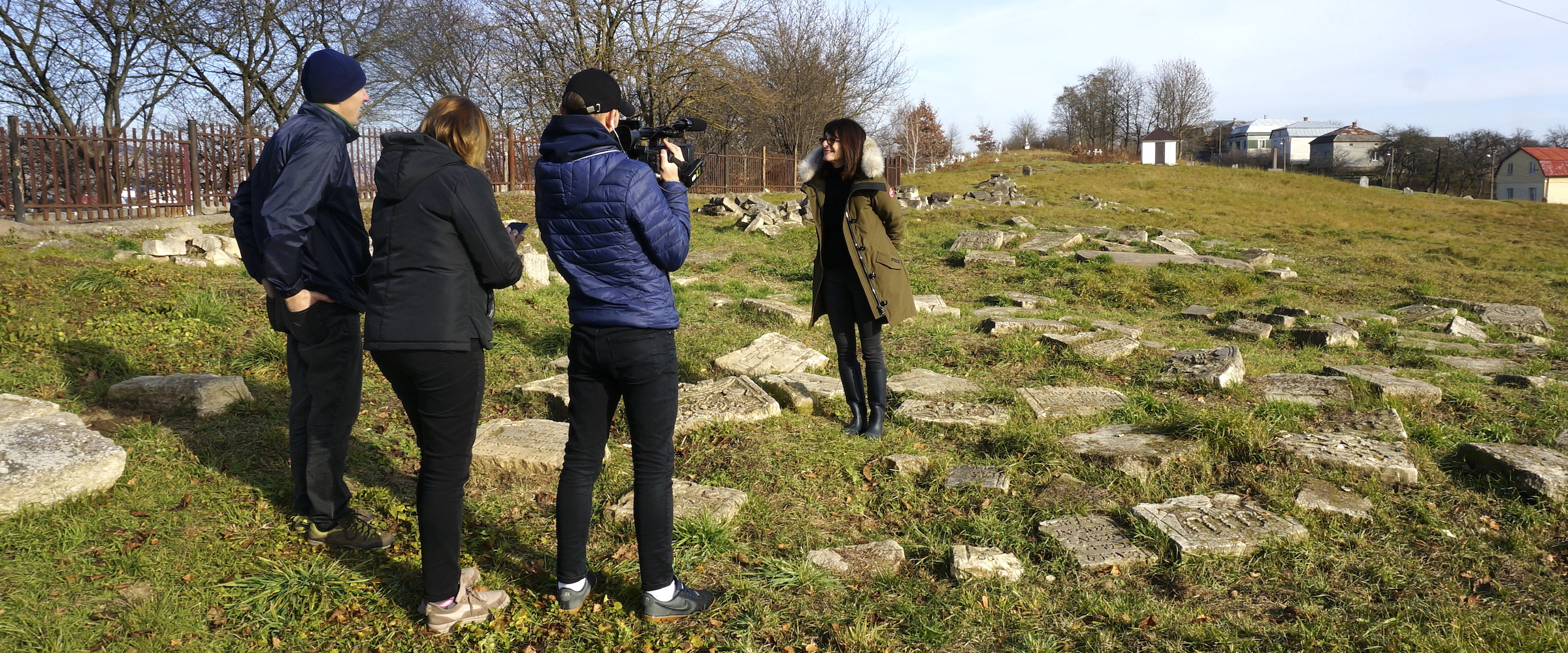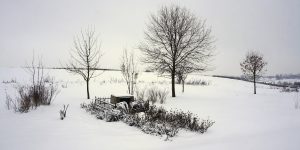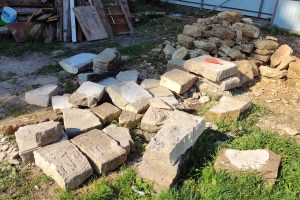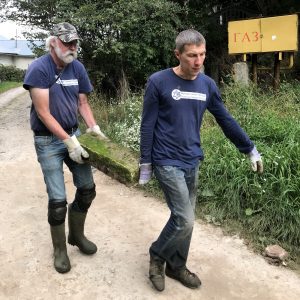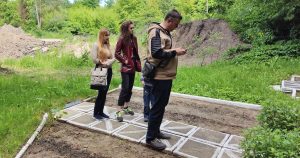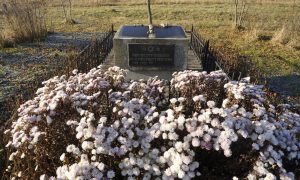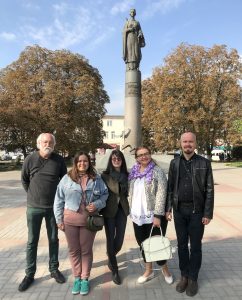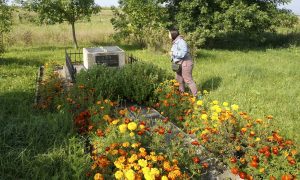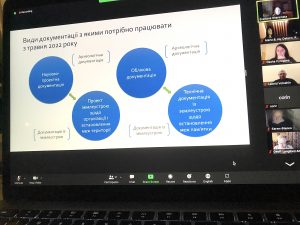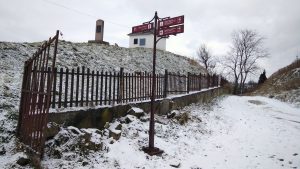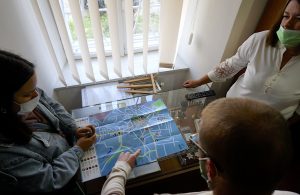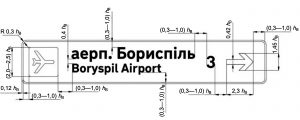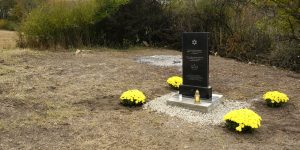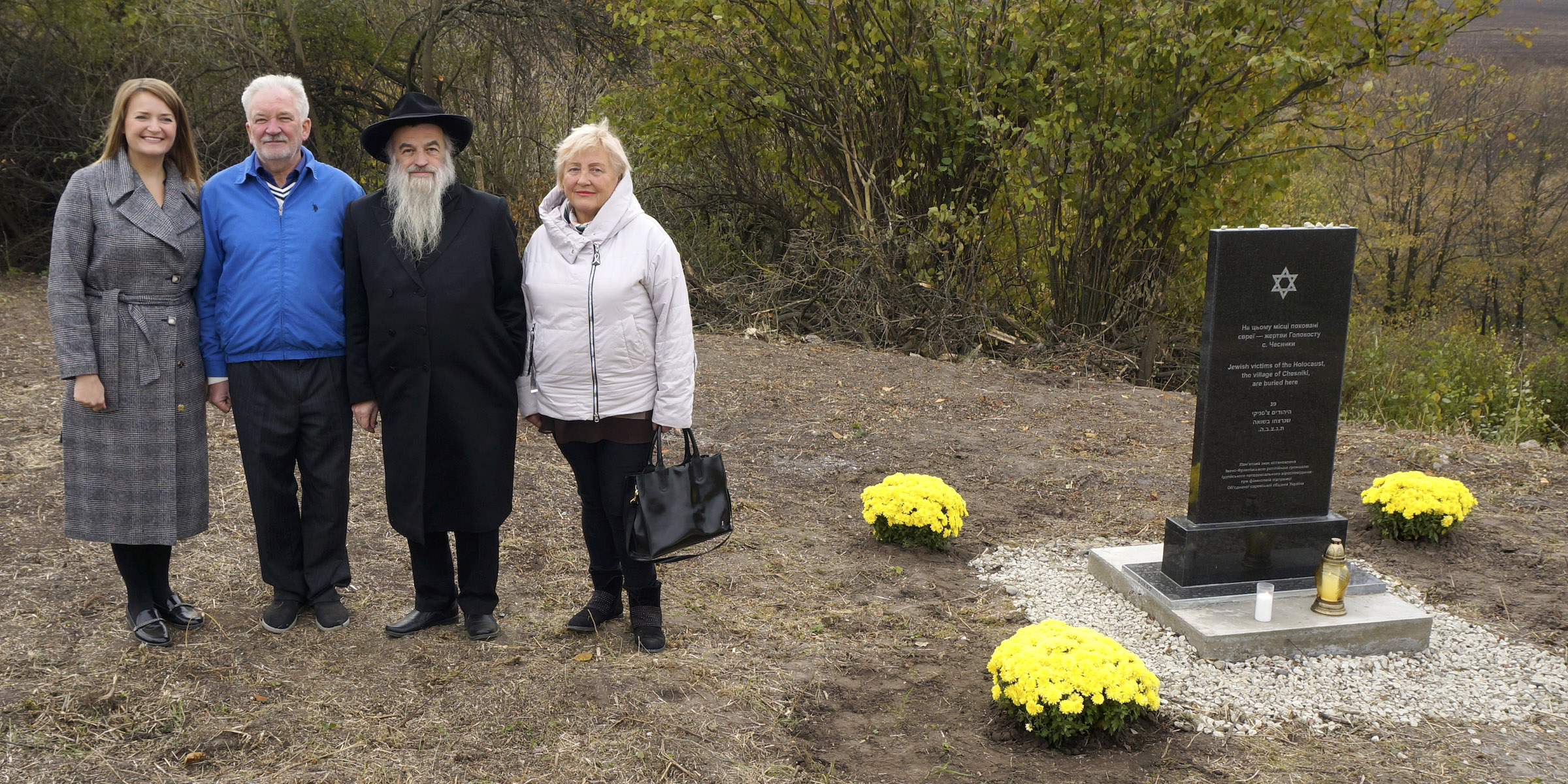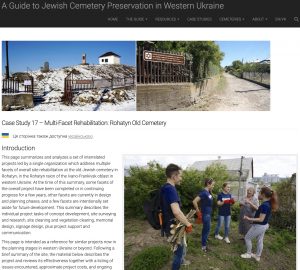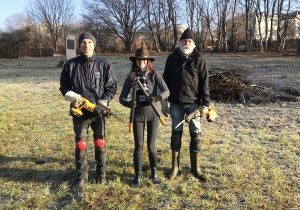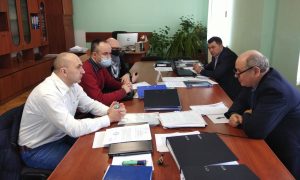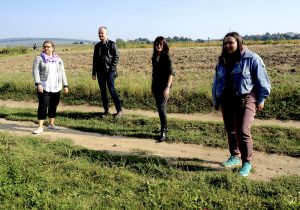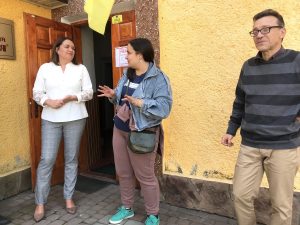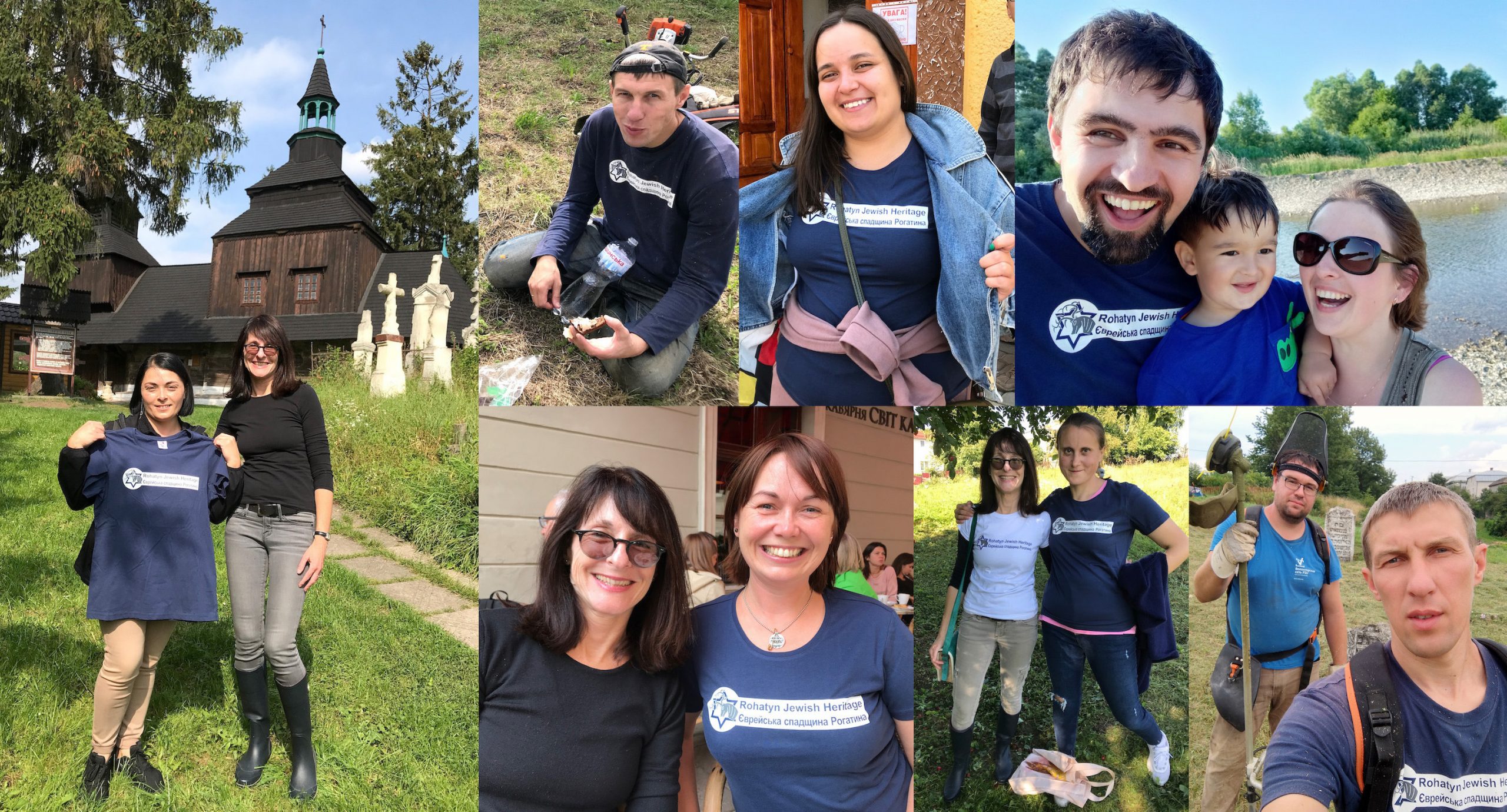This is a descriptive annual report for Rohatyn Jewish Heritage (RJH) covering the calendar year 2021. As for every year, this report summarizes our project progress and events, with an outline of our NGO finances as well. To put this unusual year in context, see our report for 2020 (prior years’ reports are also accessible in the news section of this website). Most sections of this review are hyperlinked to pages with more information, on or off of our website.
![]() Ця стаття також доступна українською.
Ця стаття також доступна українською.
THE PANDEMIC CONTINUES
At the start of this year, Marla and I had already been away from Lviv and Rohatyn for nine months, still waiting for Covid-19 vaccine development and availability. We remained in the US for another almost eight months, five waiting to be vaccinated and another three to manage personal (family and health) issues, finally returning to western Ukraine in late August.
This meant that we again relied on the kindness of our Ukrainian friends, colleagues, and contractors to care for the Jewish heritage sites in Rohatyn during our continued absence, as described below. It was with cautious joy that Marla and I returned to frequent hands-on work with our colleagues, both in Rohatyn and across the region, during the past four months.
Unfortunately, as we reach the end of 2021 the pandemic is still not receding, and infection rates in both Ukraine and the US remain high with new coronavirus variants on the horizon. Everyone we know in Ukraine has been touched either directly or indirectly by the disease, some tragically. This year we lost to complications of Covid-19 the earliest and strongest Ukrainian supporter of Rohatyn’s Jewish community, our dear friend Mykhailo Vorobets; he cannot be replaced in our work or in our hearts. Like everyone, we are adapting our planning and work as best we can but we very much look forward to a safe end to this disruption.
JEWISH CEMETERIES CLEARING AND CARE
Nature of course ignores the current health threats to humans and continues to flourish during spring, summer, and fall; this year was no different. As in 2020, our good friend and long-time volunteer Vasyl Yuzyshyn made multiple trips to Rohatyn to clear grass and wild shrubs from the Jewish cemeteries – 15 working visits before Marla and I returned, plus another 7 working with us – and he performed occasional small repairs at the sites as well.
Vasyl was joined on two working days in the cemeteries by our good friend and long-time colleague Sasha Nazar, who has helped us every year since we took up the task of maintaining the cemeteries. Sasha has his hands full with his own civil society and heritage projects, working for the Lviv Volunteer Center (LVC) and gradually restoring one of Lviv’s two surviving prewar synagogues. Volodymyr Vasylyk, who had joined Vasyl and Sasha working in the cemeteries more than once in 2020, was not able to volunteer in 2021 due to his heavy workload as a doctor in Ivano-Frankivsk, but he and his family still contributed this year to commemoration of the lost Jewish community of Rohatyn (see below).
Beyond mowing work with brushcutters (string trimmers) and light pruning work with loppers (mostly by Marla this year), in late autumn Vasyl and I further developed our tools and skills for cutting tree and shrub stumps at the burial sites, a task which is best done after mowing during the cool, slow-growth months. Now with two reciprocating saws, much more powerful Lithium-ion batteries, and saw blades selected for their ability to make pruning cuts, we are far more effective at cutting stumps flush to the ground, which eliminates trip hazards for visitors (and us), retards new growth at the stumps, and minimizes string breakage during mowing work. Vasyl and I happened to be cutting stumps in the new Jewish cemetery when Marla was interviewed by Suspilne Karpaty about our work; they captured some scenes of our new methods. We have already made good progress cutting stumps in the new cemetery and plan to continue that work in spring, after the snow melts and before new growth begins.
Before he began cutting work this year, Vasyl made several routine visits to the Jewish cemeteries and mass grave burial sites in Rohatyn just to check their condition, which we also did with him after the cutting season ended in November. On our last visit together to the sites in mid-December, the grounds and memorials were covered with a blanket of fresh snow and all was quiet. Throughout this year, the continued presence of RJH caring for the grounds has strengthened local knowledge and respect for the burial sites as part of local heritage, and given neighbors the courage to approach us to ask questions and offer help. We are grateful for that gradually growing relationship.
HEADSTONE RECOVERY
The discovery of Jewish headstone fragments scattered around Rohatyn is always unpredictable, depending as it does on new demolition or construction work in town by private property owners or by the City of Rohatyn and its utilities providers. We were able to make an unusual number of recoveries this year, after being alerted to new finds via Facebook (both our RJH page and Marla’s personal page), telephone calls, email, and other routes to Marla or Vasyl, and even face-to-face by visitors to the cemeteries while we were working.
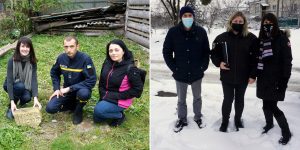
Marla with members of the Rohatyn Fire and Police Departments while investigating headstones in town. Photos © RJH.
Reports of headstones gave us an opportunity to meet representatives of both the Rohatyn fire department and the Rohatyn police department this year, a very positive development for our NGO and our future work in town. In total this year we recovered more than 20 headstone fragments, including several large pieces, on eight occasions from seven locations across Rohatyn, including one we have seen embedded into vul. Zelena for more than 8 years. Our Headstone Recovery Project page and map now record 60 separate recoveries and hundreds of headstone fragments returned to the old Jewish cemetery during the past eleven years.
This year we want to again thank our friends Tetiana Petriv and Olha Blaha (both are directors of local museums in Rohatyn) for helping us connect with citizens and officials in Rohatyn for headstone recovery. We also want to thank the Pavlyuk family as well as the Kozak and Heneha families for helping us gather headstones at or near their homes, plus Yuriy Paykush and Iryna Pastyshchyn for contacting us directly or indirectly to alert us to headstones they or others had discovered. Of course we also thank Vasyl Yuzyshyn, not only handling for much of the communication with Rohatyn residents about discovered headstones, but also for his muscle in the recovery and return of these stones to the cemetery, where they are now protected from accidental damage.

Recovering fragments at the Heneha house in Rohatyn, and delivering them to the old Jewish cemetery.
Photos © RJH.
MASS GRAVES MEMORIALS
The two known Jewish mass grave sites in Rohatyn continued to get attention and care this year, in several forms. Although Marla and I were absent from Ukraine on both of the annual dates for commemorating the victims of the first large WWII aktion (20 March, at the south mass grave) and the ghetto liquidation (6 June, at the north mass grave) in Rohatyn, we and others marked the dates around the world, and Vasyl traveled to Rohatyn on both occasions to stand at the sites and remember for all of us. Vasyl was joined by our friends the Vasylyk family of Ivano-Frankivsk for the June memorial event, and Voldymyr read aloud El Malei Rachamim in Ukrainian in front of the memorial monument.
Again this year we contracted with Ihor Zalypko, an engineer and manager at the Rohatyn vodokanal facility (where the north mass grave is located), to clear and clean the grounds surrounding the memorial monuments and to plant seasonal flowers at the sites during the warmer seasons; he again did this work diligently and with care, and we are very grateful for his efforts. RJH also cleared fast-growing grasses and shrubs as well as the poisonous giant hogweed which appears every year at the south site; Vasyl worked alone in June and then together with Marla and me for a full clearing in September.
In May, the City of Rohatyn responded positively to our request to add soil and compact it with machinery at the south mass grave in hopes of deterring further illicit digging for wartime relics at the site; fortunately the site has not been disturbed since then, but we remain vigilant with frequent site visits.
To further enhance site protection and commemoration of the mass graves, we were very pleased to learn that our project has been accepted into the current three-year phase of the Connecting Memory program in Ukraine, which Rohatyn Jewish Heritage had applied to in July of 2020 with the significant support of our friend and NGO attorney Wito Nadaszkiewicz together with our Ukrainian translator Nataliya Kurishko (also a dear friend and a long-time adviser to RJH) as well as our local partners the City administration of Rohatyn and Rabbi Kolesnyk of Ivano-Frankivsk.
Although the program will not provide funding for construction in this phase as it has for prior phases, we are being given important advice and support in other ways, including with some supplemental technical surveying but especially in navigating the complex land use recording and legal applications for inclusion of our sites in Ukraine’s national register of immovable heritage – a key prerequisite to enforcement of Ukraine’s laws covering the protection of cemeteries (which includes mass graves). We have also asked for reference design and construction data from selected sites in past phases of the program to better evaluate cost estimates and alternatives for the site designs we have commissioned. Since September we are being supported in the management of our Connecting Memory initiative by Olha Honchar, the mentor assigned to us by the program and herself an experienced project manager through her work as Director of the Memorial Museum of Totalitarian Regimes “Territory of Terror” in Lviv.
The overall Connecting Memory program has been somewhat impeded by the ongoing pandemic, but the program coordinators and specialists have adapted by accelerating the educational portion of the overall program and by moving much of the training and seminar material to remote sessions (mostly via Zoom). In the first half of next year, RJH hopes to visit the past program sites we selected as most scalable to the mass graves in Rohatyn to directly learn more about the design, construction, and process experience of the leaders of those initiatives.

Introductory meeting with our Connecting Memory mentor, Rohatyn City representatives, and RJH.
Photos © RJH.
HERITAGE SIGNAGE IN ROHATYN
2021 got off to a wonderful start in Rohatyn with the installation in mid-January of bilingual pedestrian directional signs at numerous locations around the city center. A project sponsored by the City of Rohatyn and managed by the director and staff of the Opillya local history museum, the signs point the way to more than a dozen landmarks in the city, including the old Jewish cemetery and the Jewish south mass grave. In addition to descriptive names of heritage features in both Ukrainian and English, the signs also include symbols representing the sites, with as a Star of David on the two Jewish monument symbols.
The new pedestrian signs coordinate with a large sign and map of the city installed at Roksolana Square, a logical starting point for walking tours, and with printed maps available in flyer format at the Rohatyn Opillya Museum. Other heritage features shown on these maps and on the signs include Rohatyn’s UNESCO-listed wooden Holy Spirit Church, the Turkish WWI memorial southeast of the city square, plus other churches and museums. Rohatyn is fortunate to have many historical features to attract tourists and other visitors.
Our physical signs and markers project stalled in 2020 due to our absence from Ukraine and that delay continued this year, though we were able to resume work when we returned in late summer. Inspection and evaluation of numerous road signs during our Jewish burial sites survey work in the region led us to a very capable sign design/fabrication company in the Lviv area, and we have already engaged with them to review and revise our sign concepts for driving direction and identification signs at the Jewish heritage sights. Ukraine’s national standard for road signs changed significantly in November this year, and we are adapting our design concepts to conform with the new standard now. We hope to have completed first prototypes of identification and direction road signs to bring to a strategy and planning review with Rohatyn City officials in the first half of 2022.
During the past two years we have been following a quiet and steadfast memorial marker project managed and funded by the United Jewish Community of Ukraine (UJCU) based in Dnipro, in which black granite markers are placed at Jewish cemetery and mass grave sites in Ukraine which lack other forms of identification, in cooperation with municipalities and local heritage activists. Typically the markers are inscribed with one or more Jewish symbols, the name of the Jewish community which is commemorated, and in some cases also a brief history of the community and the site. This marking effort, as a form of heritage identification, is one of the most important ways to recover and protect the memory of the prewar communities and the tragedy of the Holocaust. Marla and I have contributed to UJCU’s effort by providing comprehensive geographical and terrain information about unmarked Jewish burial sites from the nearly 350 sites we have personally visited in the three westernmost oblasts of Ukraine. In November we were pleased to join in the unveiling of a new marker in the village of Chesnyky near Rohatyn; Chesnyky Jewish families died at a killing site near the edge of the village and in the Rohatyn ghetto aktions during WWII. As the Ukraine-wide UJCU project continues in the next years, we look forward to additional markers being placed in the Rohatyn area, perhaps at the unmarked Jewish cemeteries in Bukachivtsi, Kniahynychi, and/or Zhuriv.
JEWISH BURIAL SITE CARE: BEST PRACTICES AND RESOURCES
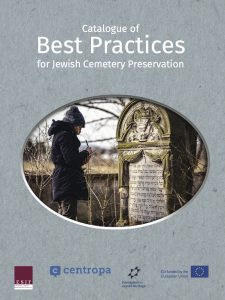
The ESJF Catalog of Best Practices.
Although the pandemic brought some of our practical work to a halt in 2020 and 2021, we found that the groundwork we had already done on Marla’s Fulbright-sponsored research project to document best practices and resources for Jewish cemetery preservation in our region (what we call “JHG”, for “Jewish Heritage Guide”) enabled us to keep developing that website, and earlier this year we completed all of the core components of the project in English. Our website was featured as a grassroots initiative in a Catalogue of Best Practices for Jewish Cemetery Preservation published this year by ESJF European Jewish Cemeteries Initiative and its partners (Rohatyn Jewish Heritage is also featured, as a “voice of the community”). Translation of the JHG website into Ukrainian is still progressing with our (overworked!) primary translator, complicated by the technical nature of many of the topics and by the sheer size of the website.
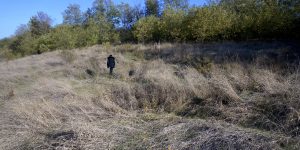
Visiting the unmarked Jewish cemetery in Ustechko (Ternopil oblast)
as part of our research this year. Photo © RJH.
The time away from Ukraine also strengthened our research into the locations and characteristics of Jewish cemeteries and mass graves in western Ukraine, and our resolve to see in person all of the burial sites which have well-define locations. Of about 530 identified cemeteries and mass graves in the Lviv, Ivano-Frankivsk, and Ternopil oblasts, two-thirds are precisely located (more than 150 mass graves are identified but without visual evidence or published research). In an intensive series of visual survey trips during the last four months of this year, with Vasyl and sometimes with other colleagues we completed our survey, reaching all but one of the known places for inspection and commemoration.
Thus the main work on this project is complete, but we will continue to refine the guide sections as we learn more from our own experience in Rohatyn and the region, and we will expand the resources as we discover new and helpful information in any medium. We anticipate occasionally adding new case studies (and have two in mind now). We will scrub the burial sites data tables as we learn new information; we believe that for descendants of Jewish families from the region, and also for municipalities and civil society NGOs in the region, this data will continue to be one of the most important elements of the research website. Of course, implementing a version of the guidance for enhancing the preservation and commemoration at Rohatyn’s burial sites remains our personal focus going forward.

Examples of stele-style memorial monuments seen in western Ukraine during our research:
Peremyshliany mass grave, Rohatyn new cemetery, Skalat destroyed cemetery, Skole mass grave near cemetery, Rohatyn old cemetery, Pidhaitsi mass grave in cemetery, Uzhhorod cemetery. Photos © RJH.
LOOKING FORWARD: PROJECTS RESUMING AND CONTINUING
The pandemic has taught us to be cautious about forecasting project work, but we can at least set some goals for 2022:
- ongoing headstone recovery, where and when fragments are found
- ongoing vegetation clearing at cemeteries and south mass grave site, including stump cutting
- 80-year commemoration at the south mass grave (20 March 2022)
- 79-year commemoration at the north mass grave (6 June 2022)
- identify fabricator and final design for information signage in the old Jewish cemetery
- prototype identification road signs fabricated for the old Jewish cemetery
- prototype directional road sign design for the old Jewish cemetery, and strategy meeting with the Rohatyn City administration
- LiDAR aerial scanning of ground terrain at the north and south mass graves and at the new Jewish cemetery
- defined strategy and first practical steps toward identification and registration of the mass grave sites in the national register of immovable heritage of Ukraine
- review and revision of a landscape and monument design for enhanced protection and commemoration of the south mass grave site
- review/specification of old cemetery memorial plans with landscape design professionals, and construction plan for first leg of memorial
- fence repairs at new Jewish cemetery
ADMINISTRATION
While the pandemic slowed or halted some of our productive activities which depend on administrative advice and support from our NGO attorney Wito Nadaszkiewicz, in 2021 RJH encountered several new legal and financial issues related to Marla’s and my foreign (US) citizenship as employees of the NGO. Most of these issues were tied to the US FATCA law which now requires mandatory documentation at banks in Ukraine, including our NGO bank. It’s important to state that we have never violated US or Ukrainian laws, and that all of our income is annually reported to both countries’ governments (and triple-taxed, because we pay our own salaries from our own personal savings). But resolving these issues required numerous forms and multiple sessions with bureaucrats and bank officials, which Wito unfortunately bore the brunt of.
In addition to managing these administrative issues, Wito took a strong leadership role for RJH in addressing gaps in legal identification, classification, and registration of the Jewish burial sites in Rohatyn. On our behalf through his firm LawCraft Legal Services and Consulting in Lviv, Wito has also engaged with the staff attorney for the Connecting Memory program to begin developing an “algorithm” or step-by-step approach to reaching final registration from the specific issues in cadastral and other regional and national databases. This has been a significant problem across Ukraine since its independence from the Soviet Union and through the transition to western-style property laws, but the Connecting Memory program has seen several successes already and we hope our cases can succeed as well in a few years.
Wito continues to hold RJH NGO legal and administrative expenses very low, waiving many incidental and even larger costs for us, which is a significant charitable gift to our small organization.
FINANCE
Independent of the pandemic or where Marla and I live, since the founding of the NGO we have maintained dual-track personal (US) and NGO (UA) bank accounts to stay flexible and reliable in receiving donations and covering project expenses. We aim for transparency by publishing our NGO income and expenses here, as in past years. We also record and acknowledge all donations (more than 30 individual donations in 2020), and every donation (less banking and transfer fees) goes directly to project expenses. Marla and I contribute additional money from our personal savings to cover all administrative, tax, and operational costs, including our own salaries, plus some incidental project expenses. The NGO income and expenses for the calendar year 2021 are listed below in US$ and using a nominal exchange rate of US$1=27UAH to allow for transfer fees and rate fluctuation (through 2021 the rate ranged 25.8UAH to 28.3UAH):
NGO projects & operations: US+UA bank accounts start balance: +$14,226 --------------------------------------- cemeteries groundskeeping -$ 2,398 mass graves groundskeeping -$ 400 headstone recovery -$ 0 misc. project labor -$ 433 tools, parts & accessories -$ 1,112 volunteer meals & other -$ 15 ground transport Lviv/Rohatyn -$ 2,210 translations EN->UA -$ 753 transcriptions RU/SXC -$ 200 signage: design stds & SW -$ 314 printing, books, etc -$ 142 project legal services -$ (comp) website domain, hosting, apps -$ 253 banking & wire transfer fees -$ 134 --------------------------------------- net change 2021: -$ 8,364 carryover 2020 expenses debt -$ 0 individual donations via GG +$ 9,597 donations from other sources +$ 0 --------------------------------------- end project banking balance: +$15,459 2021 unreimbursed expenses -$ 0 --------------------------------------- net end project balance: +$15,459 [balance = +$8905 US, +$6554 UA, -$0 debt] [remaining tools and supplies inventory is held by RJH for use in 2022] NGO administration, salaries, etc.: UA bank account start balance: +$ 4,076 --------------------------------------- permit and gov't fees -$ 363 accounting and bank fees -$ 1,250 salaries+benefits+taxes -$ 3,675 --------------------------------------- net change 2021: -$ 5,288 Osborn personal contribution +$ 7,500 --------------------------------------- end admin balance: +$ 6,288
As always, this summary may require updating after the first of the year to include late-year donations or expenses, and a final reckoning by our NGO accountant.
Once again this year we gratefully thank Gesher Galicia for its volunteer contributions, and in particular their PayPal Administrator and Operations Manager Shelley Kellerman Pollero, CFO/Treasurer Darcy Stamler, and President Steven Turner, for making the donations process to Rohatyn Jewish Heritage tax-deductible for US taxpayers and simple for everyone.
Marla and I continued to volunteer our own time throughout the year to support project work and administration of the NGO, including remotely until we could return to Ukraine. We aim to continue while we remain healthy, though we are noticeably aging; developing a transition plan for the NGO’s future will be a topic of much thought for us in the coming year.
THANK YOU TO OUR SUPPORTERS
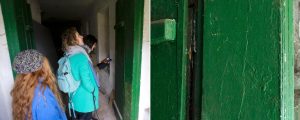
The surprise discovery with friends of a mezuzah trace on a doorframe of the former beit midrash in Rohatyn. Photos © RJH.
Every year it is clear to Marla and me how much our work depends on our supporters, including those who volunteer with us working in Rohatyn and the region, those who donate to cover the costs of our project work, and those who share ideas and encouragement with us as we continue our efforts. This awareness has been especially clear this second year of dislocation due to the pandemic, when we depended more than ever on friends and colleagues to help us maintain the Rohatyn Jewish burial sites and to progress our physical and virtual memorial projects. Unsurprisingly, the kind people who have supported us in past years continued to carry much of the burden of our heritage work this year again. We and everyone connected to Rohatyn are very fortunate for this ongoing gift.
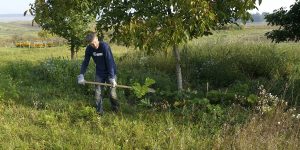
Every task is important: Vasyl clearing poisonous plants from the south mass grave site. Photo © RJH.
As was evident in news articles on this website and Facebook posts through the year, Vasyl Yuzyshyn was stalwart and heroic in his efforts both when we were absent for months and after our return to Ukraine, making a total of 36 visits to Rohatyn with or without us. Vasyl knows our work as well as we do now, speaks well for us on many occasions in both Ukrainian and English; we are proud and lucky to include him in our core team. It is always a pleasure for us to see Vasyl interact with others; his easy smile and gentle demeanor are delights to others as they are to us. After five years of working and laughing together, we cherish our strong friendship with this good man.
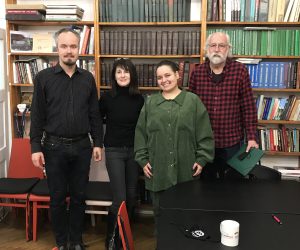
Another planning meeting with Wito and Olha at the offices of the Territory of Terror museum. Photo © RJH.
Other long-term friends and colleagues also continued their ongoing help to our NGO projects and other activities. We’ve already mentioned Sasha Nazar, who we have known now for more than 10 years, and who remains an inspiration for us in his large-hearted heritage work in Lviv and the region. We also mentioned Wito Nadaszkiewicz, who created our NGO as a Ukrainian non-profit legal entity five years ago and continues to provide much-needed advice to us and to other regional civil society initiatives to support cultural, environmental, and economic progress; his contributions to RJH projects grew this year despite the constraints of the pandemic. 2021 was yet another year in which we buried our long-time friend and primary translator Nataliya Kurishko under piles of pages – this report is yet another! This year we were pleased to finally meet Olha Honchar, director of the Memorial Museum of Totalitarian Regimes “Territory of Terror” in Lviv, an important historical and cultural resource for our work not only in the Connecting Memory program but also in the much broader project of reviving awareness and appreciation for Jewish culture in the region. We were fortunate to be able to meet with each of these old and new friends toward the end of 2021; we miss the opportunities to connect in person with other friends and supporters as we used to before the pandemic.
We are grateful that we continue to receive both tangible and intangible support from the City of Rohatyn and from our NGO partners (and friends) ESJF European Jewish Cemeteries Initiative, Yahad – In Unum, the Rohatyn District Research Group (RDRG, formerly RSRG), and Gesher Galicia.
As every year, we would like to acknowledge the many individual donors who provided funding this year to sustain our work in Rohatyn. Donations covered all of the costs of our project work this year with a small margin, thanks in part to a few very substantial gifts from family and friends but also thanks to numerous repeat donors from past years. We are pleased and proud to list this year’s and past donors on our website.
We like to end our annual reports on an amusing note, especially in difficult times. This year again the pandemic kept us apart from many people, but we still managed to spread our “brand” a little wider thanks to friends who are willing to wear our colors with pride. We say thank you again to everyone who continues to broadcast our message and effort to remember, bridge, and work together.
